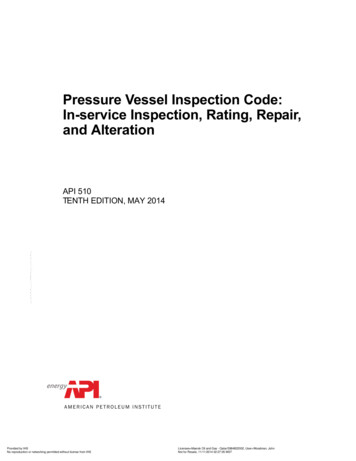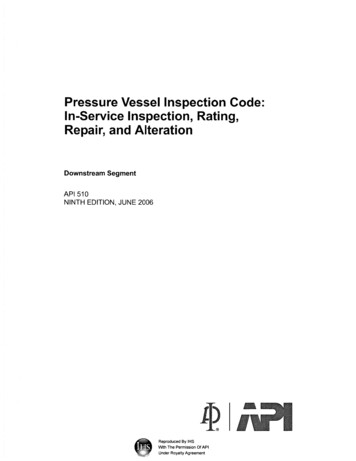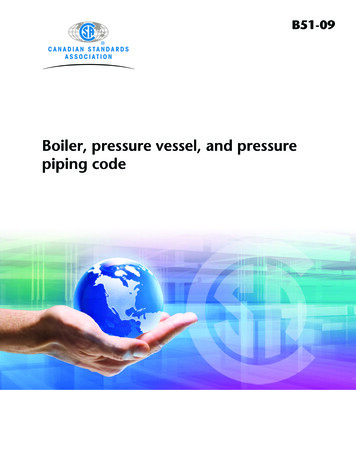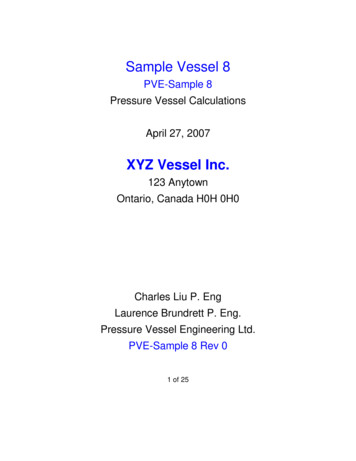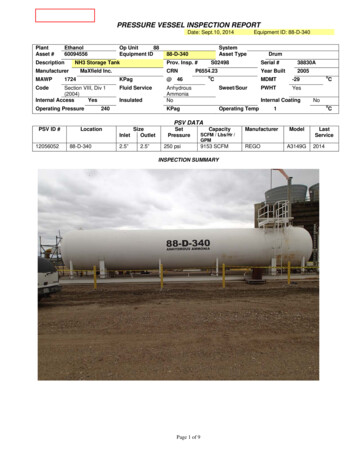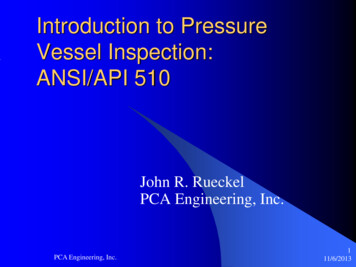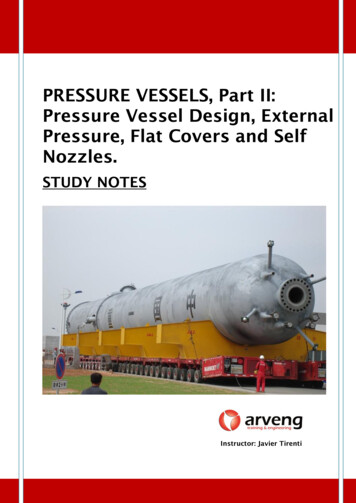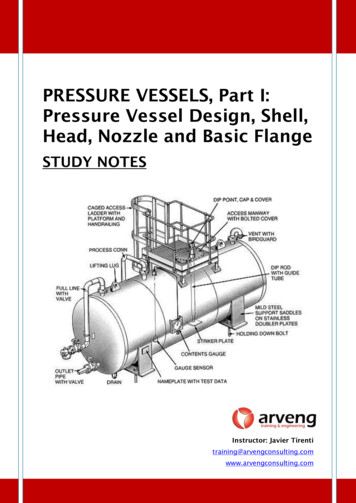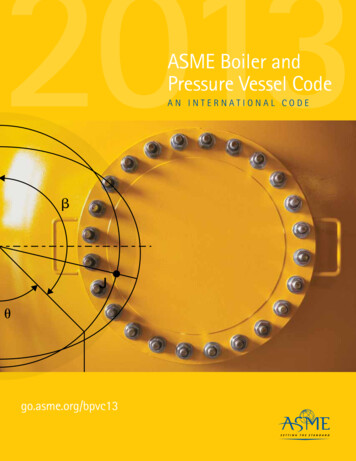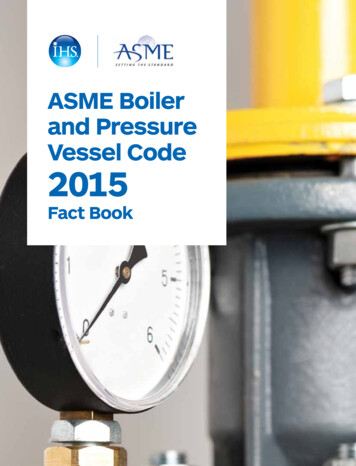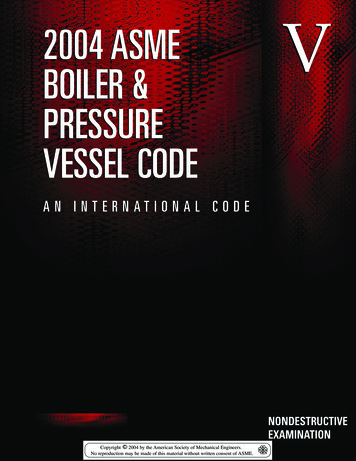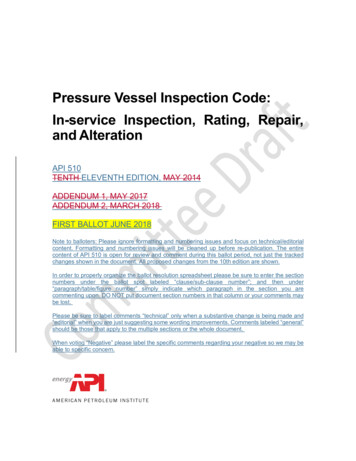
Transcription
Pressure Vessel Inspection Code:In-service Inspection, Rating, Repair,and AlterationAPI 510TENTH ELEVENTH EDITION, MAY 2014ADDENDUM 1, MAY 2017ADDENDUM 2, MARCH 2018FIRST BALLOT JUNE 2018Note to balloters: Please ignore formatting and numbering issues and focus on technical/editorialcontent. Formatting and numbering issues will be cleaned up before re-publication. The entirecontent of API 510 is open for review and comment during this ballot period, not just the trackedchanges shown in the document. All proposed changes from the 10th edition are shown.In order to properly organize the ballot resolution spreadsheet please be sure to enter the sectionnumbers under the ballot spot labeled “clause/sub-clause number”; and then under“paragraph/table/figure number” simply indicate which paragraph in the section you arecommenting upon. DO NOT put document section numbers in that column or your comments maybe lost.Please be sure to label comments “technical” only when a substantive change is being made and“editorial” when you are just suggesting some wording improvements. Comments labeled “general”should be those that apply to the multiple sections or the whole document.When voting “Negative” please label the specific comments regarding your negative so we may beable to specific concern.
Special NotesAPI publications necessarily address problems of a general nature. With respect to particular circumstances, local,state, and federal laws and regulations should be reviewed.Neither API nor any of API's employees, subcontractors, consultants, committees, or other assignees make anywarranty or representation, either express or implied, with respect to the accuracy, completeness, or usefulness of theinformation contained herein, or assume any liability or responsibility for any use, or the results of such use, of anyinformation or process disclosed in this publication. Neither API nor any of API's employees, subcontractors,consultants, or other assignees represent that use of this publication would not infringe upon privately owned rights.API publications may be used by anyone desiring to do so. Every effort has been made by the Institute to assure theaccuracy and reliability of the data contained in them; however, the Institute makes no representation, warranty, orguarantee in connection with this publication and hereby expressly disclaims any liability or responsibility for loss ordamage resulting from its use or for the violation of any authorities having jurisdiction with which this publication mayconflict.API publications are published to facilitate the broad availability of proven, sound engineering and operatingpractices. These publications are not intended to obviate the need for applying sound engineering judgmentregarding when and where these publications should be utilized. The formulation and publication of API publicationsis not intended in any way to inhibit anyone from using any other practices.Any manufacturer marking equipment or materials in conformance with the marking requirements of an API standardis solely responsible for complying with all the applicable requirements of that standard. API does not represent,warrant, or guarantee that such products do in fact conform to the applicable API standard.Users of this Standard should not rely exclusively on the information contained in this document. Sound business,scientific, engineering, and safety judgment should be used in employing the information contained herein.Work sites and equipment operations may differ. Users are solely responsible for assessing their specific equipmentand premises in determining the appropriateness of applying the Standard. At all times users should employ soundbusiness, scientific, engineering, and judgment safety when using this Standard.All rights reserved. No part of this work may be reproduced, translated, stored in a retrieval system, or transmitted by any means,electronic, mechanical, photocopying, recording, or otherwise, without prior written permission from the publisher. Contact thePublisher, API Publishing Services, 1220 L Street, NW, Washington, DC 20005.Copyright 2014 American Petroleum Institute
ForewordIn December 1931, API and the American Society of Mechanical Engineers (ASME) created the Joint API/ASMECommittee on Unfired Pressure Vessels. This committee was created to formulate and prepare for publication a codefor safe practices in the design, construction, inspection, and repair of pressure vessels to be used in the petroleumindustry. Entitled API/ASME Code for Unfired Pressure Vessels for Petroleum Liquids and Gases (commonly calledthe API/ASME Code for Unfired Pressure Vessels or API/ASME Code), the First Edition of the API/ASME Code wasapproved for publication in 1934. From its inception, the API/ASME Code contained Section I, which coveredrecommended practices for vessel inspection and repair and for establishing allowable working pressures for vesselsin service. Section I recognized and afforded well-founded bases for handling various problems associated with theinspection and rating of vessels subject to corrosion. Although the provisions of Section I (like other parts of the API/ASME Code) were originally intended for pressure vessels installed in the plants of the petroleum industry, especiallythose vessels containing petroleum gases and liquids, these provisions were actually considered to be applicable topressure vessels in most services. ASME’s Boiler and Pressure Vessel Committee adopted substantially identicalprovisions and published them as a nonmandatory appendix in the 1950, 1952, 1956, and 1959 editions of SectionVIII of the ASME Boiler and Pressure Vessel Code.After the API/ASME Code was discontinued in 1956, a demand arose for the issuance of Section I as a separatepublication, applicable not only to vessels built in accordance with any edition of the API/ASME Code but also tovessels built in accordance with any edition of Section VIII of the API/ASME Code. Such a publication appeared to benecessary to assure industry that the trend toward uniform maintenance and inspection practices afforded bySection I of the API/ASME Code would be preserved. API 510, first published in 1958, is intended to satisfy this need.The procedures in Section I of the 1951 edition of the API/ASME Code, as amended by the March 16, 1954addendum, have been updated and revised in API 510. Section I of the API/ASME Code contained references tocertain design or construction provisions, so these references have been changed to refer to provisions in the API/ASME Code. Since the release of the 1960 edition of the National Board Inspection Code, elements of the API/ASMECode have also been carried by the National Board Inspection Code.It is the intent of API to keep this publication up to date. All pressure vessel owners and operators are invited to reporttheir experiences in the inspection and repair of pressure vessels whenever such experiences may suggest a needfor revising or expanding the practices set forth in API 510.This edition of API 510 supersedes all previous editions of API 510. Each edition, revision, or addendum to this APIcode may be used beginning with the date of issuance shown on the cover page for that edition, revision, oraddendum. Each edition, revision, or addendum to this API code becomes effective six months after the date ofissuance for equipment that is rerated, reconstructed, relocated, repaired, modified (altered), inspected, and testedper this code. During the six-month time between the date of issuance of the edition, revision, or addendum and theeffective date, the user shall specify to which edition, revision, or addendum the equipment is to be rerated,reconstructed, relocated, repaired, modified (altered), inspected, and tested.Nothing contained in any API publication is to be construed as granting any right, by implication or otherwise, for themanufacture, sale, or use of any method, apparatus, or product covered by letters patent. Neither should anythingcontained in the publication be construed as insuring anyone against liability for infringement of letters patent.Shall: As used in a standard, “shall” denotes a minimum requirement in order to conform to the specification.Should: As used in a standard, “should” denotes a recommendation or that which is advised but not required in orderto conform to the specification.This document was produced under API standardization procedures that ensure appropriate notification andparticipation in the developmental process and is designated as an API standard. Questions concerning theinterpretation of the content of this publication or comments and questions concerning the procedures under whichiii
this publication was developed should be directed in writing to the Director of Standards, American PetroleumInstitute, 1220 L Street, NW, Washington, DC 20005. Requests for permission to reproduce or translate all or any partof the material published herein should also be addressed to the Director.Generally, API standards are reviewed and revised, reaffirmed, or withdrawn at least every five years. A one-timeextension of up to two years may be added to this review cycle. Status of the publication can be ascertained from theAPI Standards Department, telephone (202) 682-8000. A catalog of API publications and materials is publishedannually by API, 1220 L Street, NW, Washington, DC 20005.Suggested revisions are invited and should be submitted to the Standards Department, API, 1220 L Street, NW,Washington, DC 20005, standards@api.org.iv
Contents1.Scope1.1. General Application1.2. Specific Applications1122.3Normative References3.Terms, Definitions, Acronyms, and Abbreviations3.1. Terms and Definitions3.2. Acronyms and 5171717171818Owner/User Inspections OrganizationOwner/User Organization ResponsibilitiesEngineerRepair OrganizationInspectorExaminersOther PersonnelInspection Organization Audits5.Inspection, Examination, and Pressure Testing Practices5.1. Inspection Plans5.2. Risk-Based Inspection (RBI)5.3. Preparation for Inspection5.4. Inspection for Different Types of Damage Mechanisms and Failure Modes5.5. Types of Inspection and Surveillance for Pressure Vessels5.6. Condition Monitoring Locations (CML)5.7. Condition Monitoring Methods5.8. Pressure Testing5.9. Material Verification and Traceability5.10. Inspection of In-service Welds5.11. Inspection and Repair of Flanged Joints5.12. Inspection of Shell and Tube Heat 6.4.6.5.6.6.6.7.6.8.6.9.Interval/Frequency and Extent of InspectionGeneralInspection During Installation and Service ChangesRBIExternal InspectionInternal, On-stream, and Thickness Measurement InspectionsPressure-relieving DevicesDeferral of Inspections, Tests and ExaminationsDeferral of Inspection Repair Recommendation Due DatesReview of Inspection Repair .4.7.5.7.6.7.7.Inspection Data Evaluation, Analysis, and RecordingCorrosion Rate DeterminationRemaining Life CalculationsMaximum Allowable Working Pressure (MAWP) DeterminationAnalysis of Corroded RegionsFFS EvaluationsRequired Thickness DeterminationEvaluation of Existing Equipment with Minimal Documentation4242434444474748v
7.8. Reports and , Alterations, and Rerating of Pressure Vessels and Pressure-relieving DevicesRepairs and AlterationsTemporary RepairsPermanent RepairWelding and Hot TappingPostweld Heat Treatment (PWHT)Preheat or Controlled-deposition Welding (CDW) Methods as Alternatives to PWHTNDE of .5.9.6.Alternative Rules for E&P Pressure VesselsScope and Specific ExemptionsDefinitionsInspection ProgramPressure TestSafety Relief DevicesRecords61616162666666Annex A (normative) Code Exemptions67Annex B (normative) Inspector Certification69Annex C (informative) Sample Pressure Vessel Inspection Record71Annex D (informative) Sample Repair, Alteration, or Rerating of Pressure Vessel Form73Annex E (informative) Technical Inquiries75Figures8.18.2Rerating Vessels Using the Latest Edition or Addendum of the ASME Code Allowable Stresses . 60Sample Additional Nameplate . 61Tables7.18.1Values of Spherical Radius Factor K1 . 46Qualification Limits for Base Metal and Weld Deposit Thicknesses for the CDW Method . 57vi
Pressure Vessel Inspection Code: In-service Inspection,Rating, Repair, and Alteration1.1.1.1.1.1.ScopeGeneral ApplicationCoverageThis inspection code covers the in-service inspection, repair, alteration, and rerating activities for pressure vesselsand the pressure-relieving devices protecting these vessels. This inspection code applies to all hydrocarbon andchemical process vessels that have been placed in service unless specifically excluded per 1.2.2; but it could also beapplied to process vessels in other industries at owner/user discretion. This includes:a) vessels constructed in accordance with an applicable construction code [e.g. ASME Boiler and Pressure VesselCode (ASME Code)];b) vessels constructed without a construction code (noncode vessels)—a vessel not fabricated to a recognizedconstruction code and meeting no known recognized standard;c) vessels constructed and approved as jurisdictional special based upon jurisdiction acceptance of particular design,fabrication, inspection, testing, and installation;d) nonstandard vessels—a vessel fabricated to a recognized construction code but has lost its nameplate orstamping.However, vessels that have been officially retired from servicedecommissioned and or abandoned-in-placeabandoned in place (i.e. no longer are an asset of reco
API 510 TENTH ELEVENTH EDITION, MAY 2014 ADDENDUM 1, MAY 2017 ADDENDUM 2, MARCH 2018 FIRST BALLOT JUNE 2018 Note to balloters: Please ignore formatting and numbering File Size: 1MBPage Count: 82
